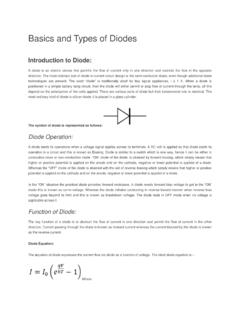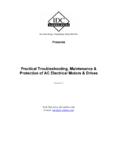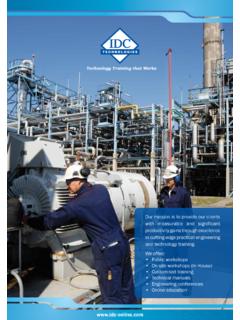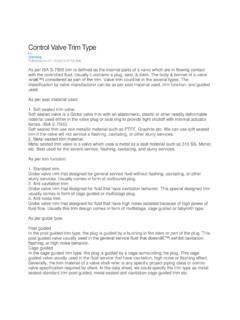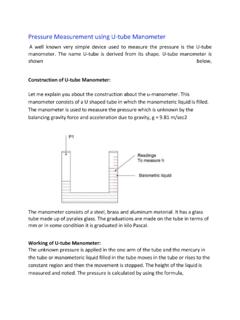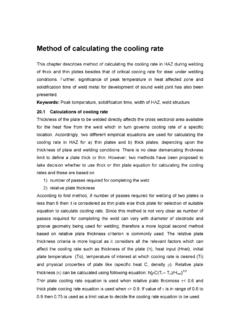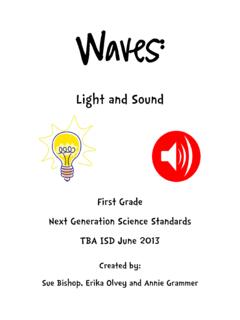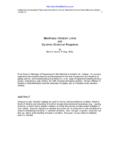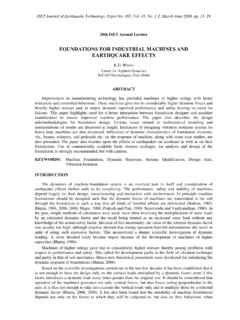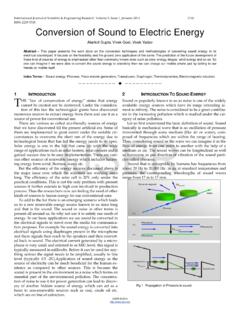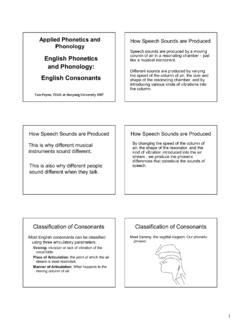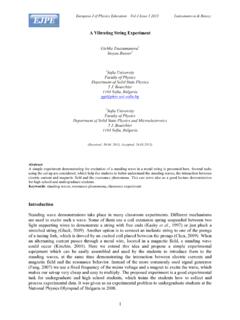Transcription of Vibration Measurement Techniques: Basics Introduction
1 Vibration Measurement Techniques: BasicsIntroduction: Vibration is the back and forth or repetitive motion of an object from its point of a force is applied to the mass, it stretches the spring and moves the weight tothe lowerlimit. When the force is removed, the stored energy in the spring causes theweight to move upward through the position of rest to its upper limit. Here, the massstops and reverses direction traveling back through the position of rest to the lowerlimit. In a friction-free system the mass would continue this motion indefinitely. Allreal systems are damped, that is they will gradually come to their rest position afterseveral cycles of motion, unless acted upon by an external characteristicsof this vibratory motion are period, frequency, displacement, velocity, acceleration,amplitude and phase. Continued Vibration of this spring mass system would onlyrepeat the characteristics shown in this single rotating machines produce vibrations that are a function of the machine dynamics,such as the alignment and balance of the rotating parts.
2 Measuring the amplitude ofvibration at certain frequencies can provide valuable information about the accuracyofshaft alignment and balance, the condition of bearings or gears, and the effect onthemachine due to resonance from the housings, piping and other Measurement is an effective, non-intrusive method to monitor machinecondition during start-ups, shutdowns and normaloperation. Vibration analysis isusedprimarily on rotating equipment such as steam and gas turbines, pumps, motors,compressors, paper machines, rolling mills, machine tools and is used to determine the operating and mechanical condition ofequipment. Amajor advantage is that Vibration analysis can identify developing problemsbeforethey become too serious and cause unscheduled downtime. This can be achievedbyconducting regular monitoring of machine vibrations either on continuous basis or atscheduled Vibration monitoring can detect deteriorating or defectivebearings, mechanicallooseness and worn or broken gears.
3 Vibration analysis can alsodetect misalignment andunbalance before these conditions result in bearing or Vibration levels can identify poor maintenance practices, suchas improperbearing installation and replacement, inaccurate shaft alignment orimprecise Characteristics of Vibrations:Modern Vibration monitoring has its genesis in the mid-1950s with the developmentand application of basic Vibration sensors, which are the heart of moderncomputerized condition monitoring systems. shows the traditionalfundamental use of Vibration monitoring in rotating machinery, , to providewarning of gradually approached or suddenly encountered excessively high vibrationlevels that couldpotentially damage the machinery. Trending a machine svibrationlevels over an extended period of time can potentially provide earlywarning ofimpending excessive Vibration levels and/or other problems and thusprovide plantoperators with valuable information for critical decision making toschedule a timelyshutdown of a problem machine for corrective action, , rebalancingthe the machine vibrations, it is usually desirable to express frequency in termsof cycles per minute, since we measure the rotational speed of machinery inrevolutions per minute.
4 This allows examination of the Vibration frequency in termsof multiples of the rotational speed is also known as thefundamental frequency and the multiples ofthe fundamentals frequencies are knownas its higher harmonics or super signatureas IndicatorAlarmlevelTrip levelTimeVibration Amplitude (m/s2)SuddenincreaseThere are three main parameters are measured to evaluate the Vibration characteristicsof any dynamic system as displacement, velocity and peak-to-peakdistance is measured from theupper limit to the lower limit, measured in mm velocity of a vibrating object is continually changing. At the upperand lower limits, the object stops and reverses its direction of travel, thus its velocityat these two points is passing through the neutral or position of rest, the velocity is at its ,the velocity is continually changing with respect to time, the peak or maximumvelocity is always measured and commonly expressed inmm-per-second peak.
5 Whenexpressing the Vibration characteristic in terms of velocity, both the displacement andfrequency are considered. Since,the vibrating object must reverse course at the peakdisplacements, this is where the maximum acceleration occurs. Like velocity,acceleration is constantly changing, and the peak acceleration is usually measurements can be important, especially in low frequency vibrationson machines that have brittle components. That is, the stress that is applied issufficient to snap the component. Many machines have cast iron frames or cases thatare relatively brittle and are subject to failure from a single large stress. Accelerationmeasurements are also important in that they directly measure force. Excessive forcecan lead to improper lubrication in journal bearings, and result in failure. Thedynamic force created by the Vibration of a rotating member can directly causebearing failure.
6 Generally a machine can withstand up to eight times its designedstatic load before bearing failure occurs. However, overloads as little as10% cancause damage over an extended period of time. Although this seems insignificant, itcan be shown that small unbalances can easily create sufficient dynamic forces tooverload the International Standards Organization (ISO), who establishes internationallyacceptableunits for Measurement of machinery Vibration , suggested the velocity root mean square(rms) as the standard unit of Measurement . This was decided in anattempt to derive criteriathat would determine an effective value for the varyingfunction of rms tends to provide the energy content in thevibration signal, whereas thevelocity peak correlated better with the intensity ofvibration. Higher velocity rms isgenerally more damaging than a similar magnitudeof velocity crest factor of a waveform is the ratio of the peak value of thewaveform to the rms value of the waveform.
7 It is also sometimes called the peak-to-rmsratio .The crest factor of a sine wave is , the peak value timesthe rmsvalue. The crest factor is one of the important features that can be used totrend discussing Vibration velocity, it was pointed out that thevelocity of the massapproaches zero at extreme limits of travel. Each time it comes toa stop at the limit oftravel, it must accelerate to increase velocity to travel to theopposite limit. Accelerationis defined as the rate of change in tothe spring-mass body, acceleration of the mass is at a maximum at theextreme limitof travel where velocity of the mass is zero. As the velocity approaches amaximumvalue, the acceleration drops to zero and again continues to rise to itsmaximum valueat the other extreme limit of of DynamicparametersThe displacement, velocity and acceleration characteristics of Vibration are measuredtodetermine the severity of the Vibration and these are often referred to as the amplitude ofthe terms of the operation of the machine, thevibrationamplitude is the first indicator toindicate how good or bad the condition of themachine may be.
8 Generally, greatervibration amplitudes correspond to higher levelsof machinery relationship between acceleration, velocity anddisplacement with respect tovibration amplitude and machinery health redefines themeasurement and data analysistechniques that should be used. Motion below 10 Hz(600 cpm) produces very littlevibration in terms of acceleration, moderate vibrationin terms ofvelocity and relativelylarge vibrations in terms of displacement. Hence,displacement is usedin this the high frequency range, acceleration valuesyield more significant values than velocityor displacement. Hence, for frequenciesover 1000 Hz(60 kcpm) or 1500 Hz (90 kcpm),the preferred Measurement unit forvibration is is generally accepted that between 10 Hz (600 cpm) and1000 Hz (60 kcpm) velocitygives a good indication of the severity of Vibration , andabove 1000 Hz (60kcpm),acceleration is the only good ,the majorityof general rotating machinery (and their defects) operates in the10 1000 Hz range,velocity is commonly used for Vibration Measurement recenttime,thereisa concerted effort to utilize Vibration monitoringin anextended role,mainlyin what is now commonly called predictivemaintenance, which is an extension and/orreplacement of traditionalpreventive maintenance.
9 [Scheffer & Girdher]An additionalbenefit of a model-based diagnostic approach is the ability tocombinemeasured Vibration signals with Vibration computer model outputs tomake real-timedeterminations of rotor Vibration signals at locations where no sensorsare , Vibration sensors are installed at or near the bearingswhere sensor accessto the rotor and survivability of sensors dictate. However,midspan locations betweenthe bearings are where operators would most like tomeasure Vibration levels butcannot because ofinaccessibility and the hostile environmentfor Vibration , the model-based approach provides virtualsensors at inaccessible Vibration using sensors:The nature of sound and vibrations to be measured can vary widely. Sound can be noisy (roar or hiss-like), like that from a heavily trafficked highway, whilevibrations of a machine are often dominated by the rotational frequency and itsmultiples.
10 A machine under constant loading gives off a stationary noise, while thenoise at an airport tends to be intermittent. Moreover, the purpose of measurementsvaries. The commonly monitored Vibration signals are displacement, velocity, basic operational principles of each of these are presented in Measurement systems that are marketed today are primarily digital, ,sound pressure and vibrations are converted into digital values for later treatment inmore or less advanced signal digital technology offers ever moresophisticated possibilities, Measurement systems are nevertheless often adapted to beable to compare Measurement results with those obtained in the past using analogtechnology. Digital Measurement systems have a more complicated structure thananalog o u n d o r v i b r a t i o n s i g n a lT r a n s d u c e rE l e c t r i c a l s i g n a lI m p e d a n c em a t c h i n gA m p l i f i c a t i o nS i g n a l c o n d i t i o n i n gM i c r o p h o n eA c c e l er o m e t e rA m p l i f i c a t i o nF r e q u e n c yT i m eS i g n a lT i m eD i g i t a lf i l t e r i n gF a s t F o u r i e rT r a n s f o r mA n a l o g f i l t e rA n a l o g-d i g i t a l c o n v e r s i o nF r e q u e n c y a n a l y s i sA m p l i t u d eF r e q u e n c yM e a s u r e m e n t d a t ap r o c e s s i n gG r a p hL o w p a s s f i l t e r i n gE x a m p l e.
